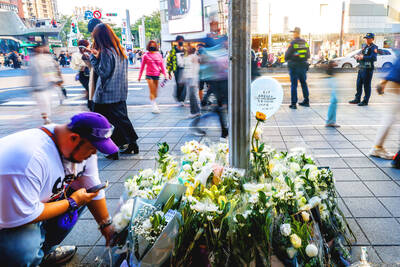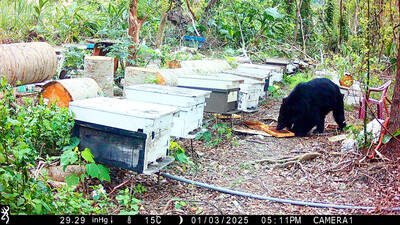A residential building in Taipei’s Neihu District (內湖) has been approved for demolition more than a decade after it was first flagged as unsafe by city engineers.
The Neihu Mingyuan Building, on the northwest side of the traffic circle on Gangqian Road, is one of many Taipei buildings constructed with concrete mixed with ocean sand instead of river sand, which is normally used. Sea sand is not considered safe for construction, as it has low compressive strength, and tends to absorb moisture from the atmosphere.
The building was initially identified to be razed in July 2010, and the building’s owner was ordered to vacate the premises before July 29, 2012.

Photo courtesy of the Taipei Urban Regeneration Office
However, a legal case delayed the demolition. The building’s tenants in 2015 sought to have Hercci Group reconstruct the property, but they were unable to agree on terms. The residents then worked with Shihlin Development to apply for an extension from the city.
After deliberations, Shihlin in 2018 reached an agreement with 80 percent of the tenants, and announced plans to begin work on Nov. 26, 2020. The city approved those plans, but the building’s owner filed an administrative lawsuit with the Taipei High Administrative Court, which overturned the city’s demolition order.
The city filed an appeal, saying that it was necessary to raze buildings constructed with sea sand to protect the safety of residents. The city won, and on Dec. 6 last year announced that demolition would proceed.
The Taipei City Urban Regeneration Office approved the demolition on Jan. 12, saying it was communicating with residents.
“A small number of households still have doubts and concerns about sharing the burdens of the project and the distribution of property rights,” the office said.
“The city will conduct a rigorous review of the plans to ensure the rights and interests of all sides,” it said.
Mediation meetings with the residents, the building owner and the contractor would be held as necessary, it added.

SHIPS, TRAINS AND AUTOMOBILES: The ministry has announced changes to varied transportation industries taking effect soon, with a number of effects for passengers Beginning next month, the post office is canceling signature upon delivery and written inquiry services for international registered small packets in accordance with the new policy of the Universal Postal Union, the Ministry of Transportation and Communications said yesterday. The new policy does not apply to packets that are to be delivered to China, the ministry said. Senders of international registered small packets would receive a NT$10 rebate on postage if the packets are sent from Jan. 1 to March 31, it added. The ministry said that three other policies are also scheduled to take effect next month. International cruise ship operators

HORROR STORIES: One victim recounted not realizing they had been stabbed and seeing people bleeding, while another recalled breaking down in tears after fleeing A man on Friday died after he tried to fight the knife-wielding suspect who went on a stabbing spree near two of Taipei’s busiest metro stations, Taipei Mayor Chiang Wan-an (蔣萬安) said. The 57-year-old man, identified by his family name, Yu (余), encountered the suspect at Exit M7 of Taipei Main Station and immediately tried to stop him, but was fatally wounded and later died, Chiang said, calling the incident “heartbreaking.” Yu’s family would receive at least NT$5 million (US$158,584) in compensation through the Taipei Rapid Transit Corp’s (TRTC) insurance coverage, he said after convening an emergency security response meeting yesterday morning. National

PLANNED: The suspect visited the crime scene before the killings, seeking information on how to access the roof, and had extensively researched a 2014 stabbing incident The suspect in a stabbing attack that killed three people and injured 11 in Taipei on Friday had planned the assault and set fires at other locations earlier in the day, law enforcement officials said yesterday. National Police Agency (NPA) Director-General Chang Jung-hsin (張榮興) said the suspect, a 27-year-old man named Chang Wen (張文), began the attacks at 3:40pm, first setting off smoke bombs on a road, damaging cars and motorbikes. Earlier, Chang Wen set fire to a rental room where he was staying on Gongyuan Road in Zhongzheng District (中正), Chang Jung-hsin said. The suspect later threw smoke grenades near two exits

The Forestry and Nature Conservation Agency yesterday launched a gift box to market honey “certified by a Formosan black bear” in appreciation of a beekeeper’s amicable interaction with a honey-thieving bear. Beekeeper Chih Ming-chen (池明鎮) in January inspected his bee farm in Hualien County’s Jhuosi Township (卓溪) and found that more than 20 beehives had been destroyed and many hives were eaten, with bear droppings and paw prints near the destroyed hives, the agency said. Chih returned to the farm to move the remaining beehives away that evening when he encountered a Formosan black bear only 20m away, the agency said. The bear